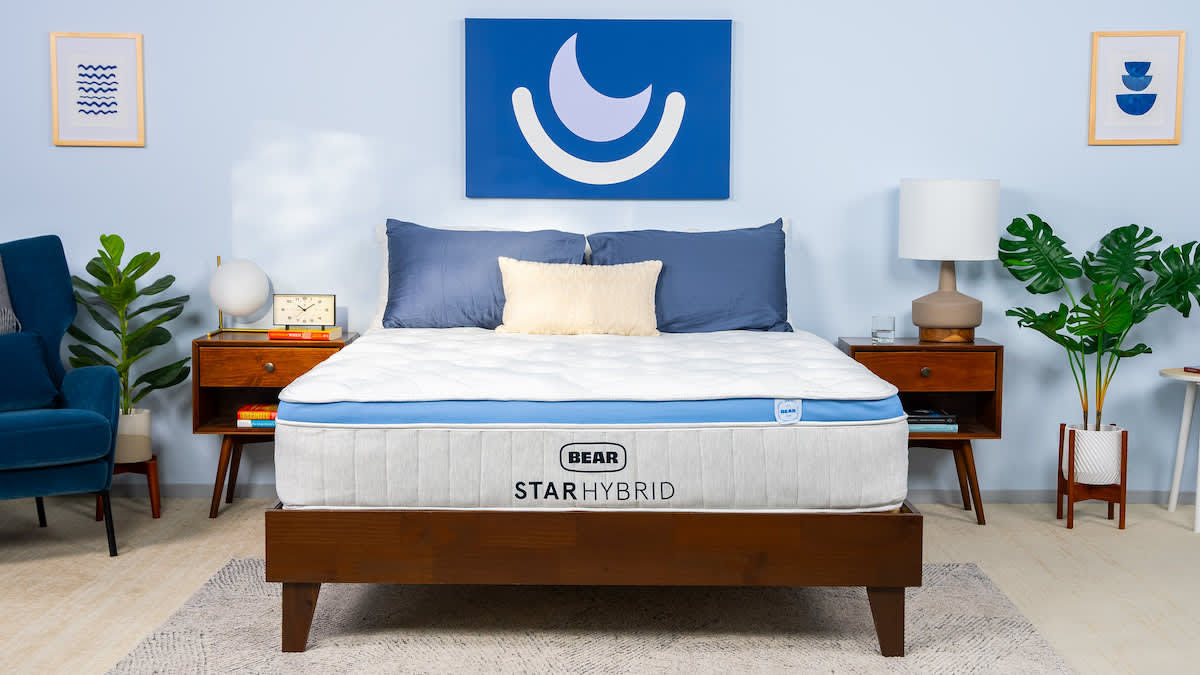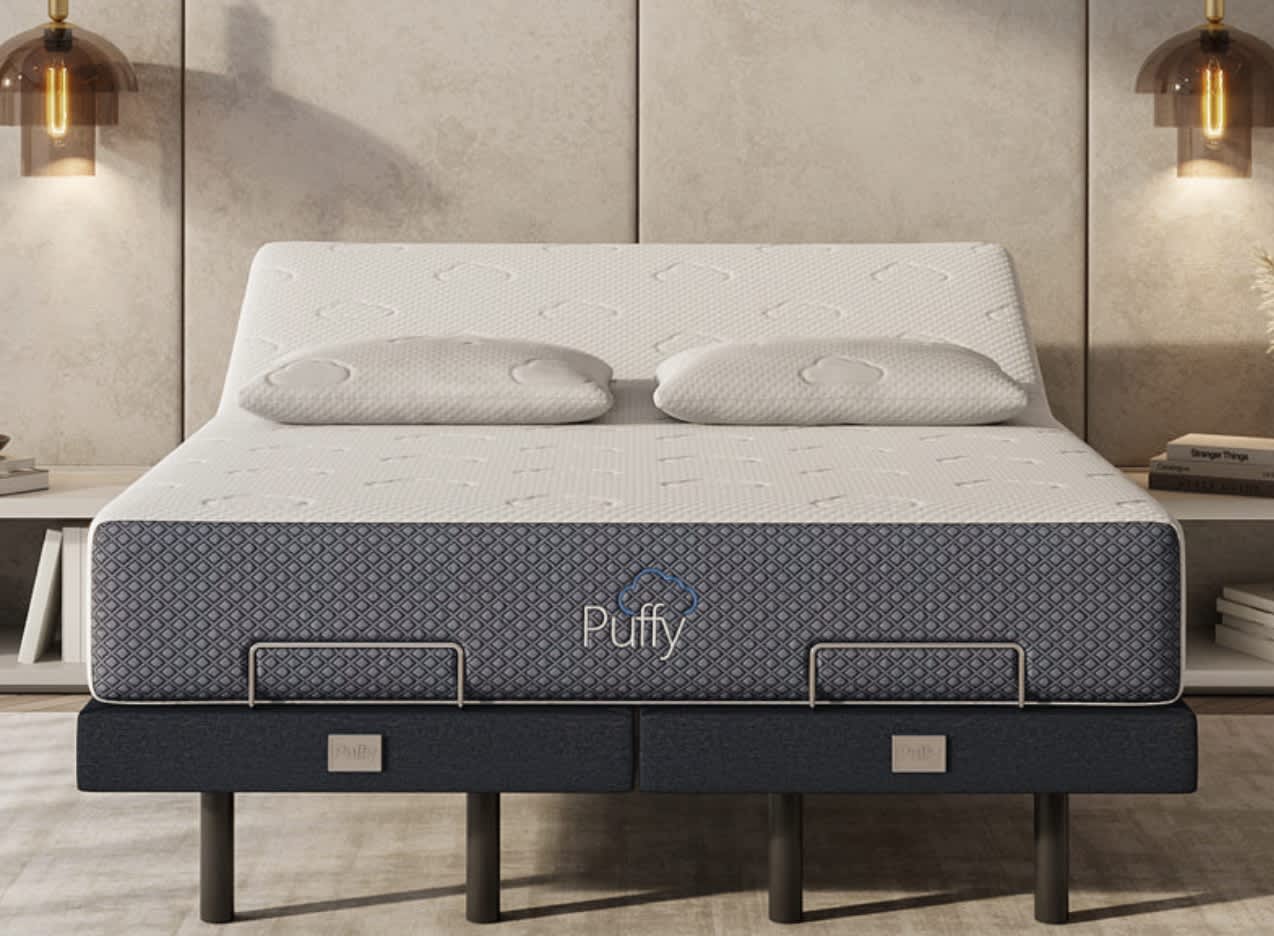On This Page
Best Mattress for Adjustable Beds
Our Top Picks
-
Best Overall Mattress
Nolah Evolution 15 -
Best Value Mattress
Bear Star Hybrid -
Best Luxury Mattress
Saatva Latex Hybrid -
Best Mattress for Pressure Relief
Puffy Cloud Mattress
Best Overall Mattress

The Nolah Evolution 15 is the quintessential hybrid, with an even balance of cushioning in the thick foam comfort layers and sturdy support in the coil system. Three firmness options makes it suitable for most sleep positions.
Pros & Cons
Pros
- Zoned coils provide targeted lumbar support and perimeter reinforcement
- Comes in a choice of three firmness levels
- Aerated foam and a breathable cotton cover help dispel excess body heat
Cons
- Thick mattress profile may require a deep pocket fitted sheet
- $99 fee for returns
- Foam layers emit some off-gassing odors after unboxing
Ratings
Our Take
Best Value Mattress

The Bear Star Hybrid is a foam-and-coil mattress that runs cooler than other foam hybrids we’ve tested, thanks to the phase change material and Celliant in the cover. The bed earned its highest marks from our side-sleeping testers, who enjoyed the mix of pressure relief and support.
Pros & Cons
Pros
- Cool, responsive surface with reliable edges
- Lower price-point than many similarly built hybrids
- Includes Celliant fibers designed to boost muscle recovery
Cons
- Sensitive co-sleepers may be disturbed by their partner’s movements
- Potential for pressure points in side sleepers under 130 pounds
- May allow too much sinkage for heavier stomach sleepers
Ratings
Our Take
Best Luxury Mattress

Some latex beds have a responsive quality that’s not for everyone, but the Saatva Latex Hybrid balances out the bouncy feel with a tufted Euro-top that deeply cushions your body. Meanwhile the latex and coils prevent uncomfortable sinkage and offer excellent support.
Pros & Cons
Pros
- Breathable, responsive construction features natural and organic materials
- Supportive hybrid design performs well for sleepers over 130 pounds
- Year-long sleep trial and free White Glove delivery to the lower 48 states
Cons
- Some motion transfer is possible when sharing the bed
- Latex may cause pressure points for side sleepers under 130 pounds
- $99 fee for returns
Ratings
Our Take
Best Mattress for Pressure Relief

The Puffy Cloud is quite plush and adaptive, so you get that deep cradling and contouring many people enjoy about memory foam. Using the mattress with an adjustable bed can enhance these qualities and prevent pressure from building in your most sensitive areas.
Pros & Cons
Pros
- Plush foam layers contour closely to cradle the body and alleviate discomfort
- Excellent motion isolation
- Seven size options including a split king for couples
Cons
- Strong off-gassing odor for the first few nights
- Too soft for most back and stomach sleepers over 230 pounds
- Foam layers may absorb and trap heat
Ratings
Our Take
Compare Our Top Picks
| Mattress | Mattress Type | Ideal For | Value | Sleep Trial |
| Nolah Evolution 15 | Hybrid | Most Sleepers | Good Value | 120 nights (30-night requirement) |
| Bear Star Hybrid | Hybrid | Couples | Good Value | 120 nights (30-night break-in period) |
| Saatva Latex Hybrid | Hybrid | Hot Sleepers | Good Value | 365 Nights ($99 Return Fee) |
| Puffy Cloud Mattress | Foam | Close-Conforming Foam | Good Value | 101 Nights |
How We Test
The Sleep Doctor team trials hundreds of mattresses in our quest to provide up to date and reliable information. To find the best mattresses for adjustable beds, our sleep testers carried out their usual pressure, motion, and temperature tests, then went a step further and tested how each mattress worked with an adjustable base.
When looking for a mattress that will work well with an adjustable bed frame, you should steer clear of old-school innerspring mattresses and instead seek out either an all-foam or hybrid option. Modern mattresses are able to bend more easily, helping you reap the benefits of your adjustable base without damaging your mattress.
What Is an Adjustable Bed?
An adjustable bed has a bed frame split into moveable sections, allowing you to raise and lower different parts of the bed. Adjustable beds typically come with a remote control or smartphone app to adjust the angles of the bed. Most are designed to work with a regular foam, hybrid, or latex mattress, with the mattress adjusting to the bed’s movements. Some adjustable beds boast special features such as massage functions, underbed lighting, and wall-hugging or zero-gravity positions.
Many, but not all, mattresses are suitable for use with an adjustable base. Notably, many traditional innerspring mattresses may not compress enough to use with an adjustable bed base.
Should You Buy an Adjustable Bed?
Adjustable beds tend to be priced higher than regular bed frames, but they offer potential advantages for conditions such as snoring, obstructive sleep apnea, fluid retention, or acid reflux and heartburn. Talk to your doctor before using an adjustable bed to treat a health condition.
Other benefits of sleeping on an adjustable bed include the freedom to read in bed or watch TV at a more comfortable angle. If you spend a lot of time in bed, an adjustable model may help reduce pressure buildup in sensitive areas.
Adjustable bases are inherently heavier and more difficult to set up compared with regular bed frames, and they may require periodic upkeep or repairs. If you already have a mattress, you’ll need to confirm it’s compatible with an adjustable base.
Pros
- May improve symptoms of certain health conditions
- More comfortable for reading or watching TV in bed
- May relieve pressure for those who spend a lot of time in bed
Cons
- More expensive than the average bed frame
- Require more complex setup and ongoing maintenance
- Incompatible with certain mattresses
What Kind of Mattress Is Best for an Adjustable Bed?
Most foam, latex, and hybrid mattresses are suitable for use with an adjustable base.
Classic innerspring mattresses don’t bend as easily and may not be appropriate. Similarly, although some airbeds are suitable for use with an adjustable base, you should check compatibility to ensure the bed’s movement won’t negatively affect the air chambers. Mattresses with profiles thicker than 13 inches may offer resistance when attempting to bend the frame.
Because adjustable bases work in close synergy with the mattress, both of these components need to come in the same size. This means that it may be difficult to find an adjustable base for custom mattress sizes.
When looking for a mattress to use with your adjustable base, you should also consider your comfort preferences. Many adjustable bed owners prefer foam or hybrid mattresses, which tend to offer closer-conforming pressure relief than latex models.
Solid vs. Split Adjustable Beds
Whereas most adjustable beds move as one unit, split adjustable beds allow each side to move independently. This design is ideal for couples with different comfort preferences. Some models are joined at the lower half but split across the upper section, so each user can choose whether to elevate the head of the bed.
What to Look For in an Adjustable Bed
Certain factors such as support, noise, and firmness level may be especially relevant when selecting a mattress to use with your adjustable bed.
Support
Many people who buy adjustable beds have back pain or other conditions that require sturdy support. A supportive mattress offers pushback in key areas to help prevent body sinkage and keep the spine on an even plane.
The bulk of a mattress’ supportive capabilities come from the support core, which is usually composed of coils or high-density polyfoam. Occasionally, a mattress may be reinforced with stronger materials to provide enhanced support to certain areas, such as the lower back.
In the upper portion of the mattress, the comfort system can also influence spinal alignment by contouring more or less closely to the body’s curves. Mattresses with closer contouring often provide improved pressure relief, but they may not be as effective at maintaining proper spinal alignment.
Firmness
Mattress firmness is subjective and depends on body weight and sleeping position. The goal when selecting a mattress is to find a firmness level that relieves pressure points without allowing the heavier parts of your body to sink in too far.
Side sleepers typically require a plusher mattress to ease pressure in the hips and shoulders, whereas stomach sleepers generally need a firm surface that keeps the hips in line with the torso.
A medium firm mattress may feel too firm to a person weighing less than 130 pounds, whereas someone weighing more than 230 pounds exerts more pressure on the mattress and may find it too soft. You may find that an extra-firm mattress isn’t flexible enough to work with an adjustable base.
Mattress Size
It’s important to verify the size and thickness of your adjustable bed before purchasing a mattress. You should also check the weight capacity, as mattresses that are too heavy for the bed frame may damage the frame or cause injury.
Noise Level
There’s a higher chance of creaks and squeaks when using an adjustable base due to the moving parts. If you use a hybrid mattress, you may also hear noises from the coils as the mattress bends along with the frame. If you’re easily bothered by noise, you may want to stick with a nonadjustable base or buy a mattress without coils.
Pricing
The average price of a queen mattress for an adjustable bed ranges from $1,000 to $2,500. This range represents the average price for a mattress in general — excepting innerspring models, which are generally incompatible with adjustable bases. The cost of the mattress must be added to the price of an adjustable base, which run between $500 and $3,000 on average.
Foam mattresses tend to be the most affordable. Mattresses featuring complex designs or those made with premium materials, such as natural latex, tend to be priced higher. Airbeds are typically the most expensive, since they have moving parts.
Split queen, split king, or split California king mattresses may cost more than a standard queen, king, or California king size mattress from the same brand.
Using Insurance to Cover an Adjustable Bed
Regular adjustable beds typically aren’t eligible for insurance coverage. However, Medicare Part B, state Medicaid programs, and private insurance plans may help with the cost of renting or owning a hospital-grade adjustable base if you require it for medical reasons, such as a nervous system injury or heart condition.
To qualify for coverage, you’ll need a prescription from your doctor and you will have to purchase the bed through a participating durable medical equipment provider. The hospital beds offered through DME providers have a more basic design intended to help with mobility and comfort. These beds are unlikely to boast massage, automatic snore response, or other sophisticated functions. Read more: How to Get Financial Assistance for Adjustable Beds.
Sleep Trial and Warranty
Online mattress sellers typically offer a sleep trial somewhere in the range of 90 to 365 nights, during which you can sleep on the mattress in your home and return it for a refund if you’re not happy. You can use the sleep trial period to test whether the mattress goes well with your adjustable bed. Just be gentle, as most companies won’t accept returns if the mattress is damaged.
Most mattresses also come with a warranty to protect against defects in materials and workmanship. Mattress warranties can last anywhere from five years to a lifetime.
Discover More Mattress Solutions
Sleep is our specialty, and mattresses are a particular area of expertise for our product testers. Check out our team’s expert picks across a range of niche categories.
More Mattress Options for Specific Needs
Mattress Type
- Best Mattress for Acid Reflux
- Best Mattress for Allergies
- Best Mattress for Arthritis
- Best Mattress for Athletes
- Best Mattress for Back Pain
- Best Mattress for Fibromyalgia
- Best Mattress for a Guest Room
- Best Mattress for Hip Pain
- Best Mattress for Platform Beds
- Best Mattress for Scoliosis
- Best Mattress for Shoulder Pain
- Best Mattress for Snoring
